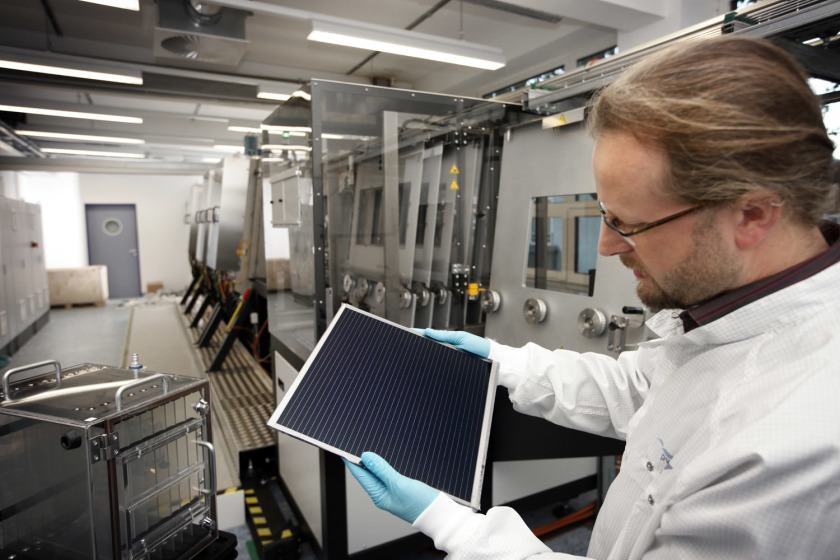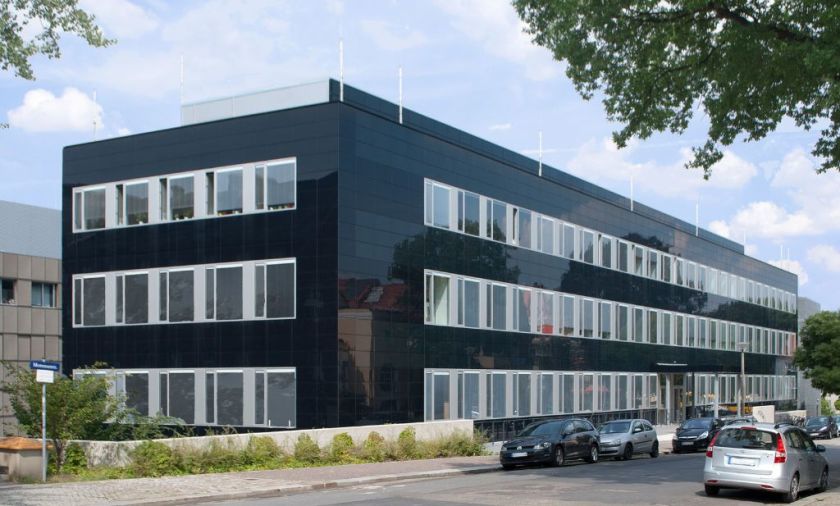Speeding up CIGS solar cell manufacture

The funding will go towards optimising a co-evaporation process at PVcomB used for producing CIGS layers for thin-film solar cells. Photo: HZB

The CIGS thin film photovoltaics can be integrated pleasingly into building architectures. Photo: Manz AG
Speeding up CIGS solar cell manufacture
A project consortium from research and industry involving the Competence Centre for Photovoltaics Berlin (PVcomB) of Helmholtz-Zentrum Berlin has been granted a major third-party-funded project by the Federal Ministry of Economics. The project “speedCIGS” is to be funded with 4.7 million euros over four years, of which 1.7 million goes to HZB. The project partners will use this money to accelerate the manufacturing process for CIGS thin-film solar cells and thus make the technology more attractive to industry.
The speedCIGS project is being carried in cooperation with systems builder Manz AG, the Center for Solar Energy and Hydrogen Research Baden-Württemberg (ZSW), the Universities of Jena and Paderborn, the Max Planck Institute Dresden and the Wilhelm Büchner Hochschule (as project coordinator).
The acquired funding will go towards optimising a co-evaporation process at PVcomB used for producing CIGS layers for thin-film solar cells. CIGS solar cells get their name from their constituent elements Copper, Indium, Gallium and Selenium. The elements are deposited together in a vacuum onto a heated substrate to form a thin layer of the desired compound. The manufacturing process used at PVcomB is already being used industrially, but is still relatively slow. The process is now to be sped up within the speedCIGS project, so that more modules can be produced per unit time for the same investment costs. This would make the production of CIGS solar modules much cheaper, giving the technology a competitive advantage in the currently tense market situation.
Also to be developed at PVcomB is a transparent p-conducting material that will go a long way towards developing high-efficiency tandem solar cells based on CIGS.
Polycrystalline CIGS solar cells already stand out for their high efficiency and high energy yields. Another advantage is the aesthetic appearance of the modules, which integrate pleasingly into building architectures.
(sz/il)
https://www.helmholtz-berlin.de/pubbin/news_seite?nid=14566;sprache=en
- Copy link
-
Battery research with the HZB X-ray microscope
New cathode materials are being developed to further increase the capacity of lithium batteries. Multilayer lithium-rich transition metal oxides (LRTMOs) offer particularly high energy density. However, their capacity decreases with each charging cycle due to structural and chemical changes. Using X-ray methods at BESSY II, teams from several Chinese research institutions have now investigated these changes for the first time with highest precision: at the unique X-ray microscope, they were able to observe morphological and structural developments on the nanometre scale and also clarify chemical changes.
-
Hydrogen: Breakthrough in alkaline membrane electrolysers
A team from the Technical University of Berlin, HZB, IMTEK (University of Freiburg) and Siemens Energy has developed a highly efficient alkaline membrane electrolyser that approaches the performance of established PEM electrolysers. What makes this achievement remarkable is the use of inexpensive nickel compounds for the anode catalyst, replacing costly and rare iridium. At BESSY II, the team was able to elucidate the catalytic processes in detail using operando measurements, and a theory team (USA, Singapore) provided a consistent molecular description. In Freiburg, prototype cells were built using a new coating process and tested in operation. The results have been published in the prestigious journal Nature Catalysis.
-
Rutger Schlatmann re-elected as ETIP PV Chair
The European Technology and Innovation Platform for Photovoltaics (ETIP PV) was created by the European Commission in order to promote photovoltaic technologies and industries in Europe. Now, the ETIP PV Steering Committee elected a new Chair, as well as two Vice-Chairs for the term 2024 – 2026. Rutger Schlatmann, head of the division Solar Energy at the HZB, and professor at HTW Berlin, was re-elected as the ETIP PV Chair.
